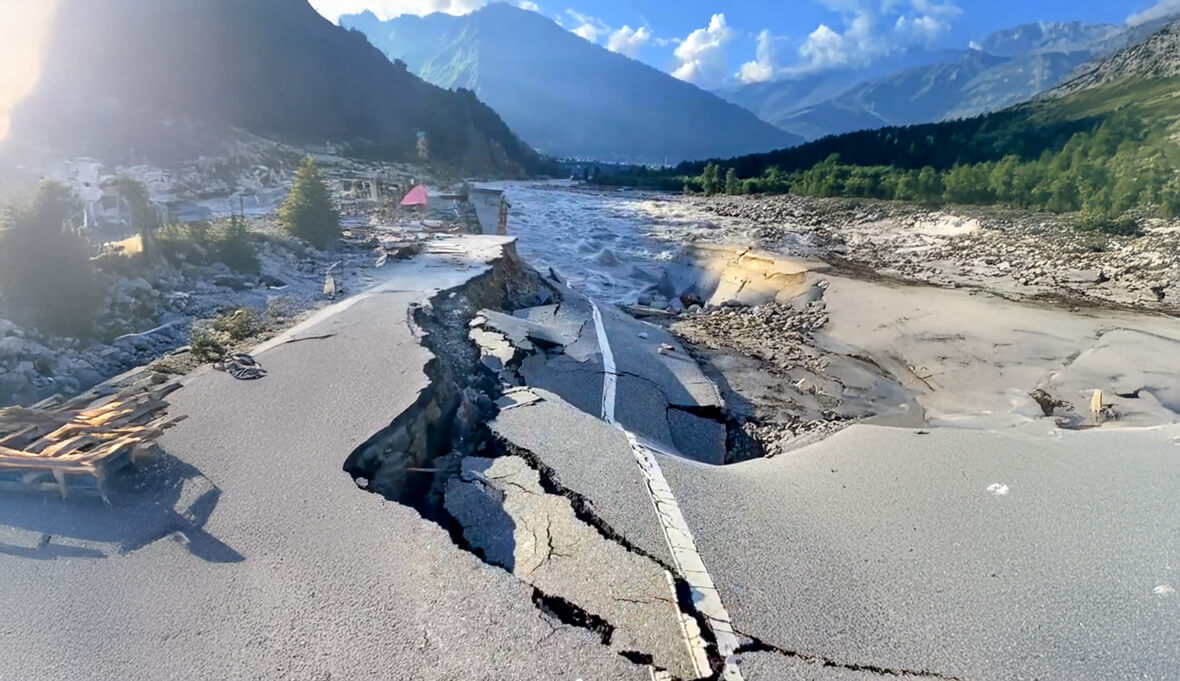The Manali Floods 2025, along with devastation in Mandi and Kullu, marked one of Himachal Pradesh’s worst monsoon disasters. From June to August 2025, flash floods, landslides, and cloudbursts shook the valley. Roads broke, bridges collapsed, homes vanished, and lives were lost.
The Manali floods 2025 disaster left 320 people dead, 38 missing, 1000+ homes destroyed, and the valley cut off for days. August 2025 was also Himachal’s wettest in 76 years, with 431.3 mm of rain against a normal 256.8 mm, 68% above average and the highest since 1949.
So what happened? Let’s walk through the timeline of Himachal floods 2025 events first and then break down why this disaster was so intense.
Himachal Floods 2025 Timeline: Key Events

Late June 2025 – The Beginning
The monsoon arrived early and hit hard. On June 25, 2025, four cloudbursts hit Kullu Valley in just 24 hours, at Manikaran, Banjar, Sainj, and Solang Valley.
-
Rivers swelled suddenly; in Kalath, floodwaters rushed into homes.
-
Tourists were trapped on washed-out roads.
-
Authorities released water from dams to ease pressure, but that only made the Beas rose even higher as a result.
What should have been the start of a scenic rainy season became the first warning of a disaster in Himachal floods 2025.
Early July – Mandi Takes the Hit
By the first week of July, Mandi district had turned into the epicenter of Himachal floods 2025.
-
On July 1–2, multiple cloudbursts ripped through villages. At least 10 people died, and 34 went missing.
-
In just two weeks, Himachal had already faced 16 cloudbursts and 3 flash floods.
-
By mid-July, the state counted 100+ deaths and 1,000 damaged homes.
The strange part? Mandi didn’t even get the most rainfall. But its geography, with steep gullies and towns built in flood-prone areas, made it far more vulnerable than neighbouring districts.
End of July – Midnight Disaster in Mandi
The scariest moment came on the night of July 28, 2025.
-
A chain of cloudbursts dumped water directly into Mandi town.
-
Normally tiny streams turned into furious rivers, roaring through markets.
-
In fact, mud, boulders, and logs buried shops and roads.
-
At least 3 lives were lost, and dozens of vehicles were swept away.
Locals described it chillingly: “We heard the sound before we saw the water. Within minutes, the streets disappeared.”
Late August – Manali Cut Off from the Rest of Himachal
Just as the valley was trying to recover, late August brought another shock.
-
From Aug 24–26, rain poured without pause.
-
The Kiratpur–Manali highway (NH-3) collapsed in several stretches.
-
The Manali–Leh highway was also washed away.
-
As a result, Kullu-Manali were cut off from the rest of Himachal for at least three days.
As a result, over 2,000 vehicles, including tourist buses and trucks loaded with apples, were stranded. In Manali town, the Old Manali bridge collapsed, and shops along the riverbank were destroyed.
On September 2, 2025, the Himachal government declared the entire state ‘disaster-affected’ under Section 34 of the National Disaster Management Act, marking the scale of devastation.
By then, the toll of the 2025 monsoon was staggering:
That’s the sequence. Now, let’s talk about why the damage was so overwhelming.
Causes of the Himachal Floods 2025
Reason 1: Climate Change and Extreme Rainfall and Floods in Himachal
The rainfall itself was unprecedented. Cloudbursts in Manali and Mandi unleashed a month’s worth of rain in just a few hours. In the Himalayas, that’s deadly; water rushes down narrow valleys in minutes.
Climate scientists point to a clear trend:
-
A warming atmosphere holds more moisture, so when it rains, it pours.
-
Himalayan glaciers are melting faster, destabilizing rivers and glacial lakes.
-
Unpredictable monsoons: long dry gaps, then sudden bursts are now common.
-
In 2025, there were even multiple glacial lake outburst floods across the Himalayas, something scientists used to expect only once in 5–10 years (WMO).
Reason 2: Unplanned Construction and Mandi–Manali Floods 2025 Damage
The floods weren’t just about rain, they were about where and how we have been building.
-
Hotels, shops, and even homes are built too close to rivers.
-
In Mandi, many buildings literally sit on old riverbeds. When the floods came, water reclaimed its natural path.
-
Seasonal streams (khads) were turned into narrow drains under roads and markets.
-
Even the government admitted this and ordered that no new government buildings will come up within 150 meters of a waterway (Hindustan Times).
Road building also made things worse:
-
For example, the Chandigarh–Manali highway was widened by pushing into the Beas’s banks. Those reclaimed portions were the first to collapse.
-
Locals had warned this “unscientific” widening would lead to slope failures. And it did.
And then there’s construction waste:
-
Contractors dumped construction debris straight into streams, blocking their flow. When the rains came, clogged rivers burst into towns.
-
Officials even noted, logs and forest debris swept down into Mandi, adding to the destruction.
-
Imagine building a city inside a storm drain, that’s exactly what happened in many parts of Himachal.
As one analysis put it: “Hazard pathways have always been there; it is the exposure that has migrated into them.”
Reason 3: Illegal Mining and Riverbed Exploitation in the Manali Floods 2025
Illegal mining played a huge role in this destruction.
-
For years, the Beas has been stripped of sand, gravel, and boulders (Hindustan Times). Miners removed those big boulders that once acted as natural “speed breakers” for the Beas.
-
Without them, the river rushed unchecked, tearing into its banks. Therefore, farmers near Manali say the river has literally shifted course over the years due to mining.
Locals agree:
-
A farmer from Bhang village recalled the 1995 flood, after which some protective walls were built but said rampant mining has made things worse.
-
“People are breaking boulders to construct houses. There is no check,” he told Hindustan Times.
Even the state’s Public Works Minister Vikramaditya Singh admitted: the Manali flooding was a “man-made disaster” due to mining.
Add to that:
-
Deforestation, which weakened slopes and triggered more landslides.
-
Hill cutting, which loosened debris that eventually filled rivers.
Nature was fierce, yes, but human greed gave it more weapons.
Reason 4: Local Beliefs and Cultural Explanations for Manali Floods
Not everyone blames only the climate or construction. Many locals believe the floods were a warning from the valley’s deities:- Sacred temples like Hadimba Devi and Bijli Mahadev are now treated like selfie stops.
-
Loud music, littering, and disrespect to customs are common.
-
Reports of illegal activities, gambling, and commercialization add to the sense of desecration.
Reason 5: Fragile Infrastructure and Delayed Relief
Conclusion: The Mountains Have Spoken
The Himachal Floods 2025 weren’t just bad weather. They were a reminder: DO NOT PROVOKE THE HIMALAYAS! The lesson is clear: development cannot come at the cost of safety.
Himachal must:
-
Keep construction away from rivers and flood channels.
-
End illegal mining and protect forests.
-
Build roads with science, not shortcuts.
-
Strengthen early-warning systems.
Above all, treat the mountains with respect. Whether you believe in climate science or deity’s wrath, the lesson is the same: respect the mountains, or they will remind you who is in charge.
Relief efforts have already faced delays due to continuous rain. Former Himachal CM Shanta Kumar urged the Union Government for a ₹20,000-crore relief package, even suggesting unused central funds be redirected to help rebuild.
Authorities will rebuild the roads, as they always do. But the homes, the lives, and the memories lost will not return so easily. This time, rebuilding must be done with respect for rivers, forests, and the gods of the valley, so that we do not repeat the same tragedy.
Manali Floods 2025: Questions People Are Asking
What caused the Manali Floods 2025?
The rain was the spark, but we gave it fuel. Hotels were built on riverbeds, boulders were pulled out for mining, forests were cut, and slopes were carved for roads without care. When the heavy rain came, nature simply reclaimed what was always hers.
How many people died in the 2025 Himachal floods?
It’s a painful number: at least 320 people lost their lives and 38 are still missing. Behind those numbers are families, homes, and memories that no rebuilding can fully replace.
Which areas were worst hit?
The floods struck hardest in Mandi, Kullu, and Manali. In Mandi’s Seraj Valley, villages like Thunag, Janjehli, and Daizy saw homes, shops, and roads washed away; Thunag Bazaar alone lost more than 60 shops. In Manali, the Old Manali bridge collapsed and parts of the highway crumbled, while Kullu markets and riverbank houses were buried under debris. Later reports also confirmed that Shimla, Kangra, Lahaul-Spiti, and Chamba faced severe damage, with Chamba emerging as one of the worst-hit districts.
Is climate change a factor?
Yes, and it’s hard to ignore now. Warmer air holds more water, which means when it rains, it doesn’t drizzle, it pours. Glaciers are melting faster, and lakes high in the mountains are turning unpredictable. Together, these changes make floods like the one in 2025 more frequent and more dangerous.
Q: Could this have been prevented?
We couldn’t stop the rain, but the destruction was on us. Hotels on riverbeds, debris in streams, roads cut into unstable slopes, and illegal mining made the Beas wild. Locals believe it’s more than that. In Dev Bhoomi, when temples become selfie spots and ropeways are pushed for money over faith, they say the gods grow silent, and the mountains scream. The floods weren’t just nature’s fury; they were also a warning about how we’ve treated rivers, forests, and even our deities.
Q: What should Himachal do now?
Keep construction away from rivers, end illegal mining, protect forests, build roads with science, and scale early-warning systems. But that’s not enough. People must also step up. Locals should avoid illegal activities that weaken the valley, while tourists must respect temples, customs, and the silence of the mountains. When both governments and communities act together, the cycle of destruction can finally be broken.












